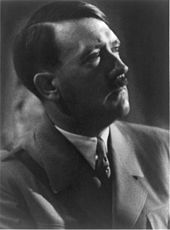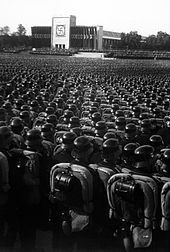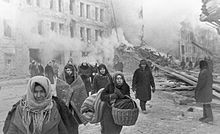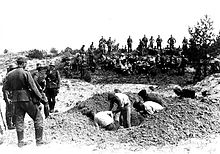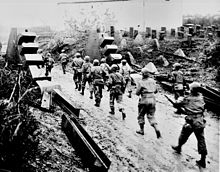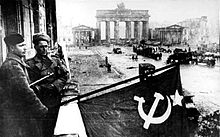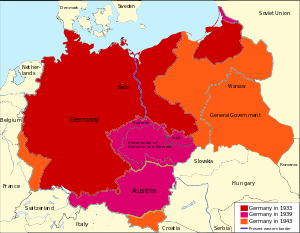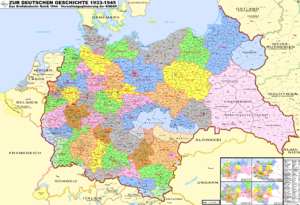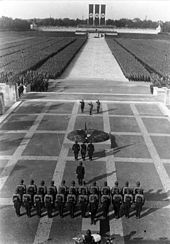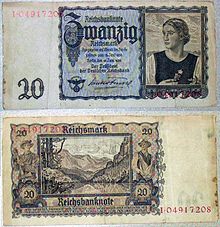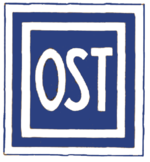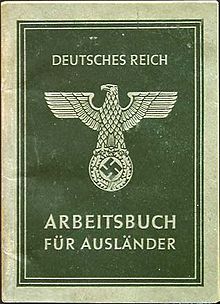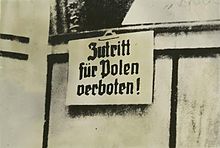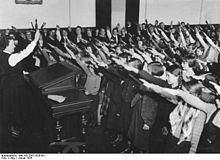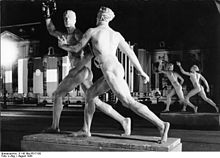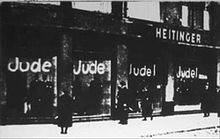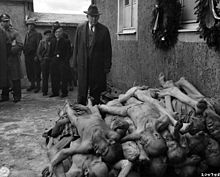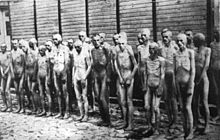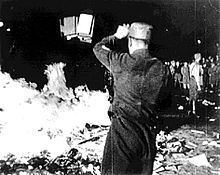
Nazi Germany
Did you know...
SOS Children made this Wikipedia selection alongside other schools resources. SOS Children works in 45 African countries; can you help a child in Africa?
| Greater German Reich Großdeutsches Reich |
||||||||||||||||||||||||||||||||||||||||||||||||||||||||||
|
||||||||||||||||||||||||||||||||||||||||||||||||||||||||||
|
||||||||||||||||||||||||||||||||||||||||||||||||||||||||||
| Motto Ein Volk, ein Reich, ein Führer "One People, one Reich, one Leader" |
||||||||||||||||||||||||||||||||||||||||||||||||||||||||||
Anthem
|
||||||||||||||||||||||||||||||||||||||||||||||||||||||||||
|
Europe at the height of German expansion, 1941–1942
|
||||||||||||||||||||||||||||||||||||||||||||||||||||||||||
| Capital | Berlin | |||||||||||||||||||||||||||||||||||||||||||||||||||||||||
| Languages | German | |||||||||||||||||||||||||||||||||||||||||||||||||||||||||
| Government | Nazi single-party state Totalitarian dictatorship |
|||||||||||||||||||||||||||||||||||||||||||||||||||||||||
| President / Führer | ||||||||||||||||||||||||||||||||||||||||||||||||||||||||||
| - | 1933–1934 | Paul von Hindenburg | ||||||||||||||||||||||||||||||||||||||||||||||||||||||||
| - | 1934–1945 | Adolf Hitler | ||||||||||||||||||||||||||||||||||||||||||||||||||||||||
| - | 1945 | Karl Dönitz | ||||||||||||||||||||||||||||||||||||||||||||||||||||||||
| Chancellor | ||||||||||||||||||||||||||||||||||||||||||||||||||||||||||
| - | 1933–1945 | Adolf Hitler | ||||||||||||||||||||||||||||||||||||||||||||||||||||||||
| - | 1945 | Joseph Goebbels | ||||||||||||||||||||||||||||||||||||||||||||||||||||||||
| Legislature | Reichstag | |||||||||||||||||||||||||||||||||||||||||||||||||||||||||
| - | State council | Reichsrat | ||||||||||||||||||||||||||||||||||||||||||||||||||||||||
| Historical era | Interwar period / WWII | |||||||||||||||||||||||||||||||||||||||||||||||||||||||||
| - | Machtergreifung | 30 January 1933 | ||||||||||||||||||||||||||||||||||||||||||||||||||||||||
| - | Gleichschaltung | 27 February 1933 | ||||||||||||||||||||||||||||||||||||||||||||||||||||||||
| - | Anschluss | 12 March 1938 | ||||||||||||||||||||||||||||||||||||||||||||||||||||||||
| - | World War II | 1 September 1939 | ||||||||||||||||||||||||||||||||||||||||||||||||||||||||
| - | Death of Adolf Hitler | 30 April 1945 | ||||||||||||||||||||||||||||||||||||||||||||||||||||||||
| - | Surrender of Germany | 8 May 1945 | ||||||||||||||||||||||||||||||||||||||||||||||||||||||||
| Area | ||||||||||||||||||||||||||||||||||||||||||||||||||||||||||
| - | 1941 (Großdeutschland) | 696,265 km² (268,829 sq mi) | ||||||||||||||||||||||||||||||||||||||||||||||||||||||||
| Population | ||||||||||||||||||||||||||||||||||||||||||||||||||||||||||
| - | 1941 (Großdeutschland) est. | 90,030,775 | ||||||||||||||||||||||||||||||||||||||||||||||||||||||||
| Density | 129.3 /km² (334.9 /sq mi) | |||||||||||||||||||||||||||||||||||||||||||||||||||||||||
| Currency | Reichsmark (ℛℳ) | |||||||||||||||||||||||||||||||||||||||||||||||||||||||||
|
||||||||||||||||||||||||||||||||||||||||||||||||||||||||||
| Today part of | ||||||||||||||||||||||||||||||||||||||||||||||||||||||||||
|
||||||||||||||||||||||||||||||||||||||||||||||||||||||||||
Nazi Germany, also known as the Third Reich, is the common name for Germany during an era where the country transformed from a democratic Republic to a totalitarian state, being ruled by Adolf Hitler as the leader of the National Socialist German Workers' Party (NSDAP) until their destruction by Allied Forces in May, 1945. On 30 January 1933 Hitler was appointed Chancellor of Germany, by the President of the Weimar Republic, Paul von Hindenburg, beginning the process of eliminating all opposition and the consolidation of power to become the sole leader of Germany. On 2 August 1934, Hitler became the dictator of Germany with the merger of the powers and offices of the Chancellery with the Presidency of the Weimar Republic. This legislation was affirmed by a national referendum vote on 19 August 1934. Through this legislation and referendum Hitler became the sole leader, Führer ("leader"), of Germany. The state idolized Hitler as its leader, centralizing all power in his hands. Historians have emphasized the hypnotic effect of his rhetoric on large audiences, and of his eyes in small groups. Kessel writes, "Overwhelmingly...Germans speak with mystification of Hitler's 'hypnotic' appeal..." Under the "leader principle," the Führer's word was above all other laws. Top officials reported to Hitler and followed his policies, but they had considerable autonomy. The government was not a coordinated, cooperating body, but rather a collection of factions struggling to amass power and gain favour with the Führer. In the midst of the Great Depression, the Nazi government restored economic stability and ended mass unemployment using heavy military spending and a mixed economy of free-market and central-planning practices. Extensive public works were undertaken, including the construction of the Autobahns. The return to economic stability gave the regime enormous popularity. All opposition to Hitler's rule was suppressed.
Racism, especially antisemitism, was a feature of society in Nazi Germany. The Gestapo (secret state police) and SS under Heinrich Himmler destroyed the liberal, socialist, and communist opposition, and persecuted and murdered Jews and other "undesirables." According to a 19th century anthropological theory, the Germanic peoples—who were also referred to as the Nordic race—were the purest representation of the Aryan race, and were therefore the master race. Education focused on racial biology, population policy, and physical fitness. Membership in the Hitler Youth organization became compulsory. The number of women enrolled in post-secondary education plummeted, and career opportunities were curtailed. Calling women's rights a "product of the Jewish intellect," the Nazis practiced what they called "emancipation from emancipation." Entertainment and tourism were organized via the Strength Through Joy program. The government controlled artistic expression, promoting specific forms of art and discouraging or banning others. The Nazis mounted the infamous Entartete Kunst (Degenerate Art) exhibition in 1937. Propaganda minister Joseph Goebbels made effective use of film, mass rallies, and Hitler's hypnotizing oratory to control public opinion. The 1936 Summer Olympics showcased the Third Reich on the international stage.
Germany made increasingly aggressive demands, threatening war if they were not met. Britain and France responded with appeasement, hoping Hitler would finally be satisfied. Austria was annexed in 1938, and the Sudetenland was taken via the Munich Agreement in 1938, with the rest of Czechoslovakia taken over in 1939. Hitler made a pact with Joseph Stalin and invaded Poland in September 1939, starting World War II. In alliance with Benito Mussolini's Italy, Germany conquered France and most of Europe by 1940, and threatened its remaining major foe: Great Britain. Reich Commissariats took brutal control of conquered areas, and a German administration termed the General Government was established in Poland. Concentration camps, established as early as 1933, were used to hold political prisoners and opponents of the regime. The number of camps quadrupled between 1939 and 1942 to 300+, as slave-laborers from across Europe, Jews, political prisoners, criminals, homosexuals, gypsies, the mentally ill and others were imprisoned. The system that began as an instrument of political oppression culminated in the mass murder of Jews and other minorities in The Holocaust.
Following the German invasion of the Soviet Union in 1941, the tide turned against the Third Reich in the major military defeats of the Battle of Stalingrad and the Battle of Kursk in 1943. The Soviet counter-attacks became the largest land battles in history. Large-scale systematic bombing of all major German cities, rail lines and oil plants escalated in 1944, shutting down the Luftwaffe (German Air Force). Germany was overrun in 1945 by the Soviets from the east and the Allies from the west. The victorious Allies initiated a policy of denazification and put the surviving Nazi leadership on trial for war crimes at the Nuremberg Trials.
Name
The official name of the state was the Deutsches Reich ("German Reich") from 1933 to 1943, and the Großdeutsches Reich ("Greater German Reich") from 1943 to 1945. The name Deutsches Reich is usually translated into English as "German Empire" or " German Reich". The term "Reich" does not always connote an empire; the official name of Germany remained "Deutsches Reich" during the Weimar period.
The most popular English terms are "Nazi Germany" and "Third Reich." The latter was adopted by the Nazis and first used in a 1923 novel by Arthur Moeller van den Bruck, that counted the medieval Holy Roman Empire (962–1806) as the first and the German Empire (1871–1918) as the second. The Nazis ignored the previous Weimar Republic (1918–1933), which the Nazis denounced as a historical aberration, contemptuously referring to it as " the System". Historiographically, Germans today refer to the period as Zeit des Nationalsozialismus or the abbreviated NS-Zeit ("National Socialist period"). A formal term frequently used in political speech or legal context is Nationalsozialistische Gewaltherrschaft (referring more specifically to the Nazi terror regime).
History
Background
The Nazi movement arose among angry young veterans in the early 1920s; they rejected the Treaty of Versailles (1919), the Weimar republic, and democracy generally. They called for a revival of the Aryan race and blamed the Jews for Germany's troubles. Highly effective Nazi propaganda effectively used the " Stab-in-the-back legend" to explain the German military defeat in 1918—that is that Jews, Communists and other subversives in Berlin were to blame. The Nazi movement was small until the onset of the 1929 global Great Depression. The subsequent fallout intensified the reaction against the modernity and liberalism of the Weimar Republic,. Simultaneously, on the left, the Communist Party of Germany, controlled by Moscow, gained strength as the middle was squeezed. Many Germans decided the Nazi Party was capable of restoring order, quelling civil unrest, and restoring Germany's international reputation.
The Nazis promised a strong authoritarian government, civic peace, radical economic policies (including full employment), increased Lebensraum ("living space") for Germanic peoples, formation of a national community based on race, and racial cleansing via the active suppression of Jews. The Nazis promised national and cultural renewal based upon the Völkisch movement, traditionalism, proposed rearmament, repudiation of reparations, and reclamation of territory lost to the Treaty of Versailles. After the federal election of 1932, the Nazis were the largest party in the Reichstag, holding 230 seats.
Nazi seizure of power
On 30 January 1933, President Hindenburg, under pressure from Franz von Papen, appointed Hitler as Chancellor of Germany. This event is known as the Machtergreifung ("seizure of power"). By becoming the Vice Chancellor and keeping the Nazis a cabinet minority, von Papen expected to be able to control Hitler. Although the Nazis had won the greatest share of the popular vote in the two Reichstag general elections of 1932, they did not have a majority, so Hitler led a short-lived coalition government formed by the NSDAP and the German National People's Party (DNVP).
Within a few months, the new government installed a single party dictatorship in Germany with legal measures establishing a coordinated central government, (see Gleichschaltung). On the night of 27 February 1933, the Reichstag building was set afire; a Dutch communist was found guilty. The Nazis claimed that the arson was a signal for a communist uprising and thousands of communist party members were arrested, the party offices raided and all KPD publications banned. The Nazis imprisoned many in the Dachau concentration camp. The Reichstag Fire Decree, imposed on 28 February 1933, rescinded most German civil liberties to suppress their opponents. The 'Fire Decree' was the second enactment that allowed the Nazi administration to restrict civil liberties. The first was a rule that forbade Germans from 'insulting the flag' and this was used consistently to repress any kind of opposition.
In March 1933, with the Enabling Act passing by 444–94 (the remaining Social Democrats), the Reichstag changed the Weimar Constitution to allow Hitler's government to pass laws without parliamentary debate for a four-year period, even such deviating from other articles in the constitution (the Act, forming the legal basis for the regime, was subsequently renewed by Hitler's government in 1937 and 1941). Forthwith, throughout 1934, the Nazi Party ruthlessly eliminated all political opposition. The Enabling Act already had banned the Communists (KPD), the Social Democrats (SPD) were later dissolved in June, and in the June–July period, the Nationalists (DNVP), the People's Party (DVP) and the German State Party (DStP) were likewise obliged to disband. Former party members were urged to join the Nazi Party or else leave politics. Moreover, at the urging of Franz von Papen, the remaining Catholic Centre Party disbanded on 5 July 1933 after obtaining Nazi guarantees for Catholic religious education and youth groups. On 14 July 1933, Germany became a de facto single-party state, as the founding of new parties was banned. Further elections in late 1933, 1936 and 1938 were entirely Nazi-controlled and only saw the Nazis and a minor number of independent "guests" (such as Hugenberg) elected for the rubber-stamp legislature.
The Nazi regime abolished the symbols of the Weimar Republic, including the black-red-gold tricolor flag, and adopted reworked imperial symbolism representing the dual nature of Germany's third empire. The previous, imperial black-white-red tricolor was restored as one of Germany's two official national flags; the second was the swastika flag of the Nazi party, which became the sole national German flag in 1935. The Nazi anthem " Horst-Wessel-Lied" ("Horst Wessel Song") became a second national anthem.
On 30 January 1934, Chancellor Hitler formally centralized government power to himself with the Act to Rebuild the Reich, by disbanding Länder (federal state) parliaments and transferring states' powers and administration to the Berlin central government. The centralization began soon after the March 1933 Enabling Act promulgation, when state governments were replaced with Reich governors. Local government also was deposed; Reich governors appointed mayors of cities and towns with populaces of fewer than 100,000; the Interior Minister appointed the mayors of cities with populaces greater than 100,000; and, in the cases of Berlin and Hamburg (and Vienna in 1938), Hitler had personal discretion to appoint their mayors.
By spring of 1934, only the army remained independent of government control; traditionally, it was separate from the national government, a discrete entity. Ernst Röhm, leader of the Nazi paramilitary Sturmabteilung (SA, "Storm Detachment"), which had several million members, intended to assume command of the army ( Reichswehr) and absorb it into its ranks. To complement the "nationalist revolution", Röhm favored a "second revolution", which would tear down industrialists, big business, the Junker aristocracy, and Prussian control of the military. Matters came to a head in June 1934 when President Hindenburg informed Hitler that if he didn't move to curb the SA he would soon dissolve the Government and declare martial law.
At the risk of appearing to talk nonsense I tell you that the National Socialist movement will go on for 1,000 years! ... Don't forget how people laughed at me 15 years ago when I declared that one day I would govern Germany. They laugh now, just as foolishly, when I declare that I shall remain in power!
— Adolf Hitler to a British correspondent in Berlin, June 1934
Hitler could not afford to lose the support of the army. Allegedly convinced by Heinrich Himmler and Hermann Göring that a plot was afoot to depose him, Hitler ordered the Schutzstaffel (SS) and the Gestapo to assassinate his political enemies both in and outside the Nazi Party with the " Night of the Long Knives". The purges of Ernst Röhm, his SA cohort, the Strasserist, left-wing Nazis, and other political enemies lasted from 30 June to 2 July 1934, and resulted in up to 200 deaths. While some Germans were shocked by the killing, others admired Hitler's decisive actions to restore order.
Upon the death of Hindenburg, on 2 August 1934, the Nazi-controlled Reichstag consolidated the offices of Reichspräsident (Reich President) and Reichskanzler (Reich Chancellor), and reinstalled Hitler as Führer und Reichskanzler (Leader and Reich Chancellor). After the "Night of the Long Knives" and Hindenburg's death, the Reichswehr was prepared to accept Hitler's leadership. As Hitler had announced plans to rearm and increase the size of the Reichswehr, the agreement of the generals was unsurprising. The assassination of Röhm and the SA leaders consolidated the Reichswehr as the sole armed force of the Reich, and the Führer's promises of military expansion guaranteed him military loyalty. Hindenburg's death facilitated transferring the German soldiers' oath of allegiance from the Reich of the Weimar Constitution to the Führer Adolf Hitler.
Shortly afterwards, the Nazis ended the official NSDAP–DNVP government alliance and began introducing Nazism and Nazi symbolism to public and private German life; textbooks were revised, or rewritten to promote a racial version of the Pan-German doctrine of Großdeutschland (Greater Germany) to be established by the Nazi Herrenvolk; teachers who opposed curricular Nazification were dismissed. Furthermore, to coerce popular obedience to the state, the Nazis established the Gestapo (secret state police), established independent of civil authority. The Gestapo controlled the German populace with some 100,000 spies and informers, and thereby were positioned to conduct surveillance of anti-Nazi criticism and dissent.
The majority of the German people were relieved that the conflicts and street fighting of the Weimar era had ended, and were deluged in a barrage of propaganda orchestrated by Joseph Goebbels, which promised peace and plenty for all in a united, Marxist-free country without the restraints of the Versailles Treaty. The first concentration camp for political prisoners was opened at Dachau near Munich in 1933 and "between 1933 and 1945, more than 3 million Germans had been in concentration camps, or prison, for political reasons". "Tens of thousands of Germans were killed for one or another form of resistance. Between 1933 and 1945, Sondergerichte (Nazi "special courts") sentenced some 12,000 Germans to death, court-martial ordered the execution of 25,000 German soldiers on charges of cowardice, while civil courts sentenced 40,000 Germans. Many of these Germans were part of the government, civil, or military service, a circumstance which enabled them to engage in subversion and conspiracy, while involved, marginally or significantly, in the government's policies."
Re-militarization of the Rhineland
Germany pulled out of the League of Nations in 1933. This move was one of Hitler's first attempts to systematically undermine and nullify the provisions of the Versailles Treaty. Hitler justified leaving the League of Nations on the grounds that the disarmament clauses were designed and applicable only to Germany, an unfair exclusion. In January 1935, the Saarland voted to become part of Germany. The region had been placed under League of Nations supervision for 15 years and the decision was greeted as a great victory for the new Germany. In March 1935 Hitler announced that the Reichswehr would be increased to 550,000 men and that there would be a German Air Force. When Britain agreed that the Germans would be allowed to build a naval fleet, the Treaty became little more than a piece of paper. The signees were ready, in the name of peace, to negotiate away on a bilateral basis the terms that Germany had agreed to in 1919.
Hitler's next attempt to undermine the Versailles Treaty came in March 1936. Italian dictator Mussolini, Hitler's colleague and at the time an object of admiration, invaded Ethiopia, leading to mild protests by the British and French governments. In the wake of this crisis, Hitler ordered the Reichswehr to march into the demilitarised zone in the Rhineland, with the proviso that they should withdraw if the French mobilised in response. The French government was in its usual state of internal bickering and Britain had no interest in stopping the Reichswehr, let alone the means. The result was a significant symbolic victory for Hitler. He had tested the resolve of his opponents and they had been found lacking. Not that there was anything they could have done, for French military strategy was dictated by the existence of the Maginot Line, behind which their army was to remain, come what may, and British politicians regarded the Rhineland as Germany's own backyard. Hitler then held an election in which he received an overwhelming vote of support and his reputation as a vigorous and determined leader was growing fast. The following year was relatively quiet on the foreign affairs front. The Spanish Civil War occupied the headlines in Europe, which was a useful trial ground for the growing Luftwaffe (German Air Force).
Anschluss with Austria
In February 1938, Austrian-born Hitler called the Austrian Chancellor Kurt Schuschnigg to a meeting at the Berghof at which he harangued Schussnigg on the need for Germans to secure their frontiers. To forestall Hitler and to preserve Austria's independence, Schuschnigg scheduled a plebiscite on the issue for 13 March, but Hitler demanded that it be canceled. On 11 March, Hitler sent an ultimatum to Schuschnigg, demanding that he hand over all power to the Austrian Nazis or face an invasion. On 12 March the Wehrmacht entered Austria, to be greeted with enthusiasm by the Austrian Germans.
Occupation of Czechoslovakia
Hitler told the leader of the Sudeten German Party, Konrad Henlein, to make a number of unacceptable demands to the Czechoslovak government. Mussolini insisted that Hitler meet the British and French prime ministers to discuss the Czechoslovak crisis. Hitler demanded the immediate annexation of the German areas (called "Sudetenland"). Two more meetings followed, in the second of which, the infamous "Munich Agreement" was signed, forcing the Czechoslovak government to accept the annexation, but having no part in the negotiations.
The Munich Agreement has had a highly controversial reception among historians and political scientists. One interpretation sees it as a cowardly " Appeasement" – an unwise and unnecessarily capitulation to vehement threats. Other scholars argue that risking war at that stage was unwise because France and Britain had neither the weapons nor a coherent strategy to defeat Germany in 1938. Chamberlain was greeted as a hero when he landed in London bringing, he said, "peace for our time." The agreement lasted six months before Hitler seized the rest of Czech territory in March 1939. Hitler's next move was to call for adjustments to the borders of Poland. In the House of Commons, Chamberlain warned that any further attempts by Hitler to change the status quo would lead to war. In effect, this declaration guaranteed help to Poland and made the outbreak of war inevitable. The Wehrmacht began to prepare for an invasion of Poland, while the German foreign office made attempts to keep Britain out of the conflict. On 23 May 1939, Hitler ordered his generals to prepare for the attack on Poland. This has been described as a typical Hitler 'bluff' by Taylor but the dynamics of mobilisation probably belie this position, for it takes several months to prepare an army for such an attack and the war began with the invasion of Poland on 1 September, just as Hitler had ordered. Hitler was still uncertain what Stalin would do when Poland was attacked. The Russian regime might be the 'anti-christ' (Kershaw) to the Nazis but it was a crucial element in the invasion of Poland. Britain and France had sent envoys to Moscow with the aim of tying Stalin into a pact. Molotov, Stalin's foreign minister, visited Berlin in July 1939 and elegant hints were dropped about the need for an agreement between Berlin and Moscow. But Stalin was in no hurry.
On 20 August, Hitler telegraphed Stalin with an offer of an agreement to be signed on 22 or 23 August. Ribbentrop, the German foreign minister, flew to Moscow and an agreement was signed between Russia and Germany that made the second world war inevitable. Hitler was delighted. He knew, he told his entourage, that Britain and France would do nothing. Their leaders were worms, he said. The compromise over Sudetenland still rankled. The agreement signed in Moscow provided for peace for a period of ten years between the two countries. There was a secret protocol attached in which Poland was divided up 'in the event of a conflict' between Russia and Germany. Russia was promised the Baltic countries, and in return Hitler could go ahead and invade Poland.
World War II
Outbreak of war
The " Danzig crisis" peaked in early 1939, around the time that reports of controversy in the Free City of Danzig increased. The United Kingdom "guaranteed" to defend Poland's territorial integrity and the Poles rejected a series of offers by Nazi Germany regarding both the Free City of Danzig and the Polish Corridor. Then, the Germans broke off diplomatic relations. Hitler had learned that the Soviet Union was willing to sign a non-aggression pact with Germany and would support an attack on Poland. Germany invaded Poland on 1 September 1939 and two days later, the United Kingdom and France declared war on Germany. World War II was underway, but Poland fell quickly, as the Soviets attacked it on 17 September. The United Kingdom proceeded to bomb Wilhelmshaven, Cuxhaven, Heligoland and other areas. Still, aside from battles at sea, no other activity occurred. Thus, the war became known as "the Phoney War".
The year 1940 began with little more than the UK dropping propaganda leaflets over Prague and Vienna but a German attack on the British High Seas fleet was followed by the British bombing the port city of Sylt. After the Altmark Incident off the coast of Norway and the discovery of the United Kingdom's plans to encircle Germany, Hitler sent troops into Denmark and Norway. This safeguarded iron ore supplies from Sweden through coastal waters. Shortly thereafter, the British and French landed in Mid- and North Norway, but the Germans de facto defeated these forces in the ensuing Norwegian Campaign.
Conquest of Europe
In May 1940, the Phoney War ended. Against the judgment of his advisors, Hitler ordered an attack on France through the Low Countries. The Battle of France ended with an overwhelming German victory. However, with the British refusing Hitler's offer of peace, the war continued. Germany and Britain continued to fight at sea and in the air. The British bombed Berlin and the German leader ordered attacks on British cities. Britain was bombed heavily during The Blitz. This change in targeting priority interfered with the Luftwaffe's objective of achieving the air superiority over Britain necessary for an invasion and allowed British air defenses to rebuild their strength and continue the fight. The Germans lost the Battle of Britain in Autumn 1940, but then turned to planning the invasion of the Soviet Union in Operation Barbarossa, June 1941. Germany and its allies invaded the Soviet Union on 22 June 1941. Hitler hoped that rapid success in the Soviet Union would bring Britain to the negotiating table.
Operation Barbarossa was supposed to begin earlier, however, failed Italian ventures in North Africa and the Balkans caused Hitler concern. In February 1941, the German Afrika Korps was sent to Libya to aid the Italians and hold the British Commonwealth forces from British-held Egypt. As the North African Campaign continued, the Afrika Korps regained lost Italian territory, pushed the British back across the desert and advanced into Egypt. In April, the Germans launched the invasion of Yugoslavia to aid friendly forces and restore control in the Balkans. This was followed by the Battle of Greece, again to bail out the Italians, and the Battle of Crete. Because of the diversions in North Africa and the Balkans, the Germans were not able to launch Barbarossa until late in June. Moreover, men and material were diverted to create the "fortified Europe" that Hitler wanted before Germany focused its attention on the East.
Nevertheless, Barbarossa began with great success. Only Hitler worried that the German Army and its allies were not advancing into the Soviet Union fast enough. By December 1941, the Germans and their allies were at the gates of Moscow; to the north, troops had reached Leningrad and surrounded the city. Meanwhile, Germany and its allies controlled almost all of mainland Europe, with the exception of neutral Ireland, Portugal, Spain, Switzerland, Sweden, and Turkey.
On 11 December 1941, four days after the Japanese bombed Pearl Harbour, Nazi Germany declared war on the United States. Not only was this a chance for Germany to strengthen its ties with Japan, but after months of anti-German hysteria in the American media and Lend-Lease aid to Britain, the leaking of Rainbow Five and the foreboding content of President Franklin D. Roosevelt's Pearl Harbour speech, Hitler concluded that the US could not be kept neutral. Moreover, Germany's policy of appeasement, designed to keep the US out of the war, was a burden on Germany's war effort. Germany had refrained from attacking American convoys, even if they were bound for the United Kingdom or the Soviet Union. By contrast, after Germany declared war on the US, the German navy began unrestricted submarine warfare, using U-boats to attack ships without warning.
The goal of Germany's navy, the Kriegsmarine, was to cut off Britain's supply line. Under these circumstances, one of the most famous naval battles in history took place, with the German battleship Bismarck, Germany's largest and most powerful warship, attempting to break out into the Atlantic and raid supply ships heading for Britain. Bismarck was sunk – but not before sending Britain's largest warship, the battlecruiser HMS Hood, to the depths of the ocean. German U-boats were more successful than surface raiders like Bismarck. However, Germany failed to make submarine production a top priority early on and by the time it did, the British and their allies were developing the technology and strategies to neutralize it. Furthermore, in spite of the submarines' early success in 1941 and 1942, material shortages in Britain failed to fall to the targeted amount: World War I levels. The Allied victory in the Battle of the Atlantic was achieved at a huge cost: between 1939 and 1945, 3,500 Allied ships were sunk (gross tonnage 14.5 million) at a cost of 783 German U-boats.
Persecution and extermination campaigns
The persecution of racial, ethnic, and social minorities and "undesirables" intensified in Germany and the occupied countries during World War II. From 1941, Jews were required to wear a yellow badge in public; most were kept in walled ghettos, where they remained isolated from the general populace. In January 1942, the Wannsee Conference, headed by Reinhard Heydrich (direct subordinate of Reichsführer-SS Heinrich Himmler), redacted the plans for the " Final Solution of the Jewish Question" (Endlösung der Judenfrage). During the Nazi regime some six million Jews, and a sizeable number of Romani people, Jehovah's Witnesses, Poles and other Slavs, Soviet POWs, people with mental and/or physical disabilities, homosexuals, and members of the political and religious opposition were massacred. Dwarfs, or little people, were persecuted by the Nazis, as well. Altogether, more than ten million people were put into forced labour. In 1978, the term "Holocaust" came into general use to describe this genocide in English. It is called the Shoah in Hebrew.
In addition to eliminating the Jews, the Nazis also planned the ethnic cleansing of some 30–45 million Slavs (Poles, Russians, Ukrainians, etc.). This strategy was to make way for 10 million German settlers. It was the Generalplan Ost (General Plan East) for the conquest, ethnic cleansing, and exploitation of the populaces of the captured territories. The food that went to Russians would be diverted to the German army and German civilians. The Russians would starve and their cities razed and turned into forests. Nationalists of peoples who had lived under Soviet rule as well as anti-communists of all nationalities collaborated with the Nazi occupation. The populaces of Nazi-occupied Soviet Russia who racially qualified as of the Aryan race, or had no immediate Jewish ancestors, were not persecuted, and often were recruited into the Waffen-SS divisions.
Eventually, the Nazi regime meant to Germanize the racially acceptable Volk (ethnic groups) of occupied eastern Europe, with the rest to be exterminated. Parts of the plan were implemented in Polish areas annexed by Nazi Germany, with the classification of Poles on the Nazi Volksliste, according to their racial characteristics. People classified as Germans who nonetheless resisted were sent to concentration camps. Those who were not classified as Germans were expelled. Ethnic Germans from the Baltic states were encouraged to leave them, and were settled in Poland in the houses of the expelled Poles. These, and the Poles classified as Germans, were subjected to programs to Germanize them. Children were also abducted from Eastern Europe for Germanization.
Turning point

In late 1941, the Red Army counter-attacked Hitler's offensive, and, by winter's end, the Wehrmacht were no longer immediately outside Moscow. Yet the Germans and their allies held a strong line, and, in the summer, launched a major attack against the petroleum fields of the Caucasus in Southern Russia. To secure the flanks of this offensive, a line at the Volga had to be held, which led to the Battle of Stalingrad (17 July 1942 – 2 February 1943), wherein Germany and its allies were defeated. After winning a major tank battle at Kursk-Orel in July 1943, the Red Army progressed west towards Germany; henceforth, the Wehrmacht and its allies remained on the defensive.
In Libya, the Afrika Korps failed to break through the line at First Battle of El Alamein (1–27 July 1942), having suffered repercussions from the Battle of Stalingrad. Beginning in 1942, Allied bombing of Germany increased, severely damaging, among others, the cities of Hamburg, Cologne and Dresden, killing thousands of civilians, and causing hardship for the survivors. Contemporary estimates of Nazi German military dead at this point of the war are 5.5 million.
In November 1942, the Wehrmacht and the Italian Army retreated to Tunisia, where they fought the Americans and the British in the Tunisia Campaign (17 November 1942 – 13 May 1943). The Allies invaded Sicily and Italy thereafter, but met fierce resistance, particularly at Anzio (22 January 1944 – 5 June 1944) and Cassino (17 January 1944 – 18 May 1944). The campaign continued from mid-1943 to nearly the end of the war. In June 1944, American, British and Canadian forces established the western front with the D-Day (6 June 1944) landings in Normandy, France. After the successful Operation Bagration (22 June – 19 August 1944), the Red Army was in Poland; and in East Prussia, West Prussia, and Silesia the German populaces fled en masse, fearing Communist persecution, atrocity, and death. In spring of 1945, the Red Army was at Berlin; US and UK forces had conquered most of west Germany (and would go on to meet up with the Red Army at Torgau on the Elbe on 26 April 1945).
Collapse
During the Battle of Berlin (16 April 1945 – 2 May 1945), Hitler and key staff members lived in the armoured, underground Führerbunker while above ground the Red Army fought remnant forces made up of the German army, Hitler Youth, and Waffen-SS for control of the ruined capital city of Nazi Germany. In the Führerbunker, Hitler became psychologically isolated and detached. At the situation conference of 22 April, Hitler suffered a total nervous collapse when he was informed that the instructions he had issued the previous day for SS-General Felix Steiner's Army Detachment Steiner to move to the rescue of Berlin had not materialised. Hitler openly declared for the first time the war was lost and blamed the generals. Hitler announced he would stay in Berlin until the end and then shoot himself. On 23 April, as Berlin became more isolated, Hermann Göring sent Hitler an ultimatum, threatening to assume command of Nazi Germany if he received no reply—which he would interpret as Hitler being incapacitated. Upon receiving the ultimatum, the Führer ordered Göring's immediate arrest, and despatched an aeroplane delivering the reply to Göring in Bavaria. By 25 April the Red Army encirclement of Berlin was complete and secure radio communications with defending units had been lost; the command staff in the bunker complex were depending on telephone lines for passing orders and on public radio for news and information. Despite the losses of armies and lands, the Führer neither relinquished power, nor surrendered. On 28 April, a BBC report stated that Reichsführer-SS Heinrich Himmler had offered surrender to the western Allies. Hitler ordered Himmler's arrest and had Hermann Fegelein (Himmler's SS representative at Hitler's HQ in Berlin) shot.
On 30 April 1945, after intense street-to-street combat in Berlin, when Soviet troops were within a block or two of the Reich Chancellery, Hitler and Eva Braun committed suicide in his Führerbunker. Two days later, on 2 May 1945, German General Helmuth Weidling unconditionally surrendered Berlin to Soviet General Vasily Chuikov.
Hitler was succeeded by Grand Admiral Karl Dönitz as Reich President and Goebbels as Reich Chancellor. No one was to replace Hitler as the Führer, a position Hitler abolished in his will. However, Goebbels committed suicide outside the Reich Chancellery a day after assuming office. The caretaker government Dönitz established near the Danish border unsuccessfully sought a separate peace with the Western Allies. On 4–8 May 1945 most of the remaining German armed forces throughout Europe surrendered unconditionally ( German Instrument of Surrender, 1945). This was the end of World War II in Europe.
Aftermath
Casualties
The war was the largest and most destructive in human history, with 60 million dead across the world, including approximately 6 million Jews who perished during the Holocaust, 3 million Soviet prisoners of war and at least 3 million civilian non-Jewish victims of Nazi crimes. The Soviet Union lost around 27 million people during the war, about half of all World War II casualties. One in four Soviets were killed or wounded. The postwar Soviet population was 45 to 50 million smaller than it would have been if pre-war demographic growth had continued. Towards the end of the war, Europe had more than 40 million refugees, the European economy had collapsed, and 70% of the European industrial infrastructure was destroyed.
War crimes
The United Nations organized trials of Nazi leaders for war crimes and crimes against humanity. At the Nuremberg Trials, the first, major trial was the Trial of the Major War Criminals Before the International Military Tribunal (IMT), of 24 key Nazi officials—including Hermann Göring, Ernst Kaltenbrunner, Rudolf Hess, Albert Speer, Karl Dönitz, Hans Frank, and Julius Streicher. Most defendants were found guilty, 12 were sentenced to execution. The victorious Allies outlawed the Nazi Party, its subsidiary organizations, and most of its symbols and emblems especially the swastika throughout Germany and Austria; this prohibition remains in force.
Allied occupation
With the creation of the Allied Control Council on 5 July 1945, the four Allied powers "assume[d] supreme authority with respect to Germany" ( Declaration Regarding the Defeat of Germany, U.S. Department of State, Treaties and Other International Acts Series, No. 1520).
The Allies' Potsdam Conference in August 1945 created arrangements for the Allied occupation and denazification of the country, as well as war reparations involving the removal of war-related factories. All German annexations in Europe after 1937, and Germany's eastern border was shifted westwards to the Oder-Neisse line. France took temporary control of a large part of Germany's remaining Saar region. The Allies each had its zone, which lasted until 1949; Berlin was also divided four ways, and remained under Allied control until 1990.
Geography
Pre-war territorial changes
The German national borders in 1933 were those mapped out by the victors in World War I, at the Treaty of Versailles (1919). To the north, Germany was bounded by the North Sea, Denmark, and the Baltic Sea; to the east, it was divided into two and bordered Lithuania, the Free City of Danzig, Poland, and Czechoslovakia; to the south, it bordered Austria and Switzerland, and to the west, it touched France, Luxembourg, Belgium, the Netherlands, and the Saarland. These borders changed after Germany regained control of the Saarland, transformed itself into Greater Germany by annexing Austria in the Anschluss (1938), and also gained control of the Sudetenland, the remainder of Bohemia and Moravia, and the Memel Territory before the war. Germany expanded further by seizing even more land during World War II, which began in September 1939.
In the years leading to war, in addition to the Weimar Republic proper, the Reich came to include areas with ethnic German populations, such as Austria, the Czechoslovak Sudetenland, and the Lithuanian territory of Memel (the Klaipėda Region). Regions conquered after the war's start include Eupen-Malmedy, Alsace-Lorraine, Danzig, and territories of Poland (Second Polish Republic).
Administrative divisions
To consolidate Adolf Hitler's control of Germany, in 1935, the Nazi régime de facto replaced the administration of the Länder ( constituent states) with gaus (regional districts) headed by governors answerable to the central Reich government in Berlin. The reorganization politically weakened Prussia, which had historically dominated German politics. Moreover, despite having centralised and assumed the Gau governments, some Nazis still retained leadership title to the different Länder; Hermann Göring was and remained the Reichsstatthalter (Reich state governor) and Minister President of Prussia until 1945, and Ludwig Siebert remained as Minister President of Bavaria.
Wartime expansion
From 1939 to 1945, the Third Reich ruled the ethnically-Czech parts of Czechoslovakia as the Protectorate of Bohemia and Moravia, with its own currency; Czech Silesia was incorporated into the province of Silesia; and Luxembourg was a wartime annexation in 1940. Central Poland and Polish Galicia were governed by the German-administered General Government. Eventually, the Polish people were to be removed, and Poland proper then re-populated with 5 million Germans. By late 1943, Nazi Germany had conquered South Tyrol and Istria, which had been parts of Austria-Hungary before 1919, and seized Trieste after the (erstwhile Axis Ally) Italian Fascist government capitulated to the Allies. Two puppet-districts were set up in their place, the Operational Zone of the Adriatic Littoral and the Operational Zone of the Alpine Foothills.
Occupied territories
Beyond the territories incorporated into Germany were the Reichskommissariate (Reich Commissariats), quasi-colonial regimes established in a number of occupied countries and regions that were ruled by Nazi civilian administrators ( Reichskommissars). Although "outside" of the Reich in a legal sense these were intended for eventual incorporation into it, most notably as sources for future Lebensraum. Nazi-occupied Soviet Russia included the Reichskommissariat Ostland (encompassing the Baltic states, eastern parts of Poland, and western parts of Belarus) and a Reichskommissariat Ukraine. More such districts, the Reichskommissariat Moskowien for much of Western Russia, the Reichskommissariat Kaukasus for the Caucasus, and the Reichskommissariat Turkestan for Central Asia were also proposed in the event that they were brought under German rule.
In Northern and Western Europe, the Germans established a Reichskommissariat Norwegen (Norway), and a Reichskommissariat Niederlande (the Netherlands). In June 1944 a Franco–Belgian Reichskommissariat, derived from the previous Military Administration in Belgium and Northern France was also established to "facilitate" the area's intended annexation into Germany. This subsequently happened in December 1944, when it was split into three new Reichsgaue of the Greater German Reich: Flanders, Wallonia, and Brussels. This meant little in reality however as the majority of Belgium had already been liberated by the Allied forces at this point, although the Wehrmacht did make some small gains in retaking Wallonia during the Ardennes offensive.
Hitler and other leading Nazi politicians believed that the non-German Germanic peoples of Europe, such as the Scandinavians, the Dutch, and the Flemish, were part of the " Aryan master race". Hitler stated that he wanted to undo the "unnatural division" of the Nordic race into many different countries ("Kleinstaatengerümpel"). This was expanded on by Nazi ideologists, who made the analogy that since the union with Austria had transformed the German Reich into a Greater German Reich (Grossdeutsches Reich), so too would its union with the rest of historically Germanic Europe create a Greater Germanic Reich (Grossgermanisches Reich). The United Kingdom however was expected to be accorded a somewhat higher status, as partners in the Nazis' New Order rather than subjects. Hitler professed an admiration for the British Empire and its people as proof of Aryan superiority in Zweites Buch.
Post-war changes
The de facto borders of the Reich changed long before its vanquishment in May 1945; as the Red Army progressed westwards (colonist German populaces fled to Germany proper) and as the Western Allies advanced eastwards from France. At war's end, a small strip of land, from Austria to Bohemia and Moravia (and other isolated regions) was the only area not occupied by the Allies. Upon its defeat, some historians have proposed that the Reich was in debellation. France, the Soviet Union, the United Kingdom, and the United States, established occupation zones. The prewar German lands east of the Oder-Neisse line and Stettin, and environs (nearly 25 percent of pre-war German territory) were under Polish and Soviet administration, sundered for Polish and Soviet annexation; the Allies expelled the German inhabitants. In 1947, the Allied Control Council disestablished Prussia with Law No. 46 (20 May 1947); per the Potsdam Conference (6 July – 2 August 1945), the Prussian lands east of the Oder-Neisse Line were divided and administered by Poland and the Kaliningrad Oblast, pending the final peace treaty Later, by signing the Treaty of Warsaw (1970) and the Treaty on the Final Settlement with Respect to Germany (1990), Germany renounced claims to territories lost during World War II (1939–45).
Politics
The Nazi state idolized Hitler as its Führer ("Leader"), centralizing all power in his hands. Nazi propaganda centered on Hitler and created what historians call the "Hitler Myth" – that Hitler was all-wise and that any mistakes or failures by others would be corrected when brought to his attention. In reality, Hitler had a narrow range of interests, and decision-making was diffused among overlapping, feuding power centers; on some issues he was passive, simply assenting to pressures from whoever had his ear. Top officials reported to Hitler and followed his basic policies, but they had considerable autonomy on a daily basis. Through staffing of most government positions with Nazi Party members, by 1935 the German national government and the Nazi Party had become virtually one and the same. By 1938, through the policy of Gleichschaltung, local and state governments lost all legislative power and answered administratively to Nazi Party leaders, known as Gauleiters, who governed Gaue and Reichsgaue.
Government structure
Nazi Germany was made up of various competing power structures, all trying to gain favour with the Führer, Adolf Hitler. Thus many existing laws were stricken and replaced with interpretations of what Hitler wanted. Any high party/government official could take one of Hitler's comments and turn it into a new law, of which Hitler would casually either approve or disapprove. This became known as "working towards the Führer", as the government was not a coordinated, co-operating body, but a collection of individuals each trying to gain more power and influence through the Führer. This often made government very convoluted and divided, especially with Hitler's vague policy of creating similar posts with overlapping powers and authority. The process allowed the more unscrupulous and ambitious Nazis to get away with implementing the more radical and extreme elements of Hitler's ideology, such as anti-Semitism, and in doing so win political favour. Protected by Goebbels' extremely effective propaganda machine, which portrayed the government as a dedicated, dutiful, and efficient outfit, the dog-eat-dog competition and chaotic legislation was allowed to escalate. Historical opinion is divided between "intentionalists", who believe that Hitler created this system as the only means of ensuring both the total loyalty and dedication of his supporters and the impossibility of a conspiracy; and "structuralists", who believe that the system evolved by itself and was a limitation on Hitler's supposedly totalitarian power.
- Executive Cabinets
- Hitler Cabinet
- Cabinet Schwerin von Krosigk
- National authorities
- Chancellery of the Führer ( Philip Bouhler)
- Office of the Party Chancellery ( Martin Bormann)
- Office of the Presidential Chancellery ( Otto Meißner)
- Office of the Reich Chancellery ( Hans Lammers)
- Privy Cabinet Council ( Konstantin von Neurath)
- Reich Ministries
- Reich Foreign Ministry ( Joachim von Ribbentrop)
- Reich Interior Ministry ( Wilhelm Frick, Heinrich Himmler)
- Reich Ministry of Public Enlightenment and Propaganda ( Joseph Goebbels)
- Reich Ministry of Aviation ( Hermann Göring)
- Reich Ministry of Finance ( Lutz Schwerin von Krosigk)
- Reich Ministry of Justice ( Franz Gürtner, Otto Thierack)
- Reich Economics Ministry ( Alfred Hugenberg, Kurt Schmitt, Hjalmar Schacht, Hermann Göring, Walther Funk)
- Reich Ministry for Nutrition and Agriculture ( Richard Walther Darré, Herbert Backe)
- Reich Labour Ministry ( Franz Seldte)
- Reich Ministry for Science, Education, and Public Instruction ( Bernhard Rust)
- Reich Ministry for Ecclesiastical Affairs ( Hanns Kerrl)
- Reich Transportation Ministry ( Julius Dorpmüller)
- Reich Postal Ministry ( Wilhelm Ohnesorge)
- Reich Ministry for Weapons, Munitions, and Armament ( Fritz Todt, Albert Speer)
- Reich Ministry for the Occupied Eastern Territories ( Alfred Rosenberg)
- Reich Ministers without Portfolio ( Konstantin von Neurath, Hans Frank, Hjalmar Schacht, Arthur Seyss-Inquart)
- Reich offices
- Office of the Four Year Plan ( Hermann Göring)
- Office of the Inspector for Highways
- Office of the President of the Reich Bank
- Reich Main Security Office ( Reinhard Heydrich)
- Office of the Reich Master Forester ( Hermann Göring)
- Reich Youth Office
- Reich Treasury Office
- General Inspector of the Reich Capital
- Office of the Councilor for the Capital of the Movement (Munich, Bavaria)
- NSDAP offices
- NSDAP Office of Racial Policy
- NSDAP Office of Colonial Policy
- NSDAP Office of Foreign Affairs
- Amt Rosenberg
State ideology
National Socialism had some of the key ideological elements of fascism which originally developed in Italy under Benito Mussolini; however, the Nazis never officially declared themselves fascists. Both ideologies involved the political use of militarism, nationalism, anti-communism and paramilitary forces, and both intended to create a dictatorial state. The Nazis, however, were far more racially oriented than the fascists in Italy, Portugal, and Spain. The Nazis were also intent on creating a completely totalitarian state, unlike Italian fascists who while promoting a totalitarian state, allowed a larger degree of private liberties for their citizens. These differences allowed the Italian monarchy to continue to exist and have some official powers. However the Nazis copied much of their symbolism from the Fascists in Italy, such as copying the Roman salute as the Nazi salute, use of mass rallies, both made use of uniformed paramilitaries devoted to the party (the SA in Germany and the Blackshirts in Italy), both Hitler and Mussolini were called the "Leader" (Führer in German, Duce in Italian), both were anti-Communist, both wanted an ideologically driven state, and both advocated a middle-way between capitalism and communism, commonly known as corporatism. The party itself rejected the fascist label, claiming National Socialism was an ideology unique to Germany.
The totalitarian nature of the Nazi party was one of its principal tenets. The Nazis contended that all the great achievements in the past of the German nation and its people were associated with the ideals of National Socialism, even before the ideology officially existed. Propaganda accredited the consolidation of Nazi ideals and successes of the regime to the regime's Führer ("Leader"), Adolf Hitler, who was portrayed as the genius behind the Nazi party's success and Germany's saviour.
The "German problem", as it is often referred to in English scholarship, focuses on the issue of administration of Germanic regions in Northern and Central Europe, an important theme throughout German history. The "logic" of keeping Germany small worked in the favour of its principal economic rivals, and had been a driving force in the recreation of a Polish state. The goal was to create numerous counterweights in order to "balance out Germany's power".
The Nazis endorsed the concept of Großdeutschland, or Greater Germany, and believed that the incorporation of the Germanic people into one nation was a vital step towards their national success. It was the Nazis' passionate support of the Volk concept of Greater Germany that led to Germany's expansion, that gave legitimacy and the support needed for the Third Reich to proceed to conquer long-lost territories with overwhelmingly non-German population like former Prussian gains in Poland that it lost to Russia in the 19th century, or to acquire territories with German population like parts of Austria. The German concept of Lebensraum or more specifically its need for an expanding German population was also claimed by the Nazi regime for territorial expansion.
Two important issues were administration of the Polish corridor and Danzig's incorporation into the Reich. As a further extension of racial policy, the Lebensraum program pertained to similar interests; the Nazis determined that Eastern Europe would be settled with ethnic Germans, and the Slavic population who met the Nazi racial standard would be absorbed into the Reich. Those not fitting the racial standard were to be used as cheap labour force or deported eastward.
Racialism and racism were important aspects of society within the Third Reich. The Nazis combined antisemitism with anti-Communist ideology, regarding the leftist-internationalist movement—as well as international market capitalism—as the work of "Conspiratorial Jewry". They referred to this so-called movement with terminology such as the "Jewish-Bolshevistic revolution of subhumans". This platform manifested itself in the displacement, internment, and systematic extermination of an estimated 11 million to 12 million people in the midst of World War II, roughly half of them being Jews targeted in what is historically remembered as the Holocaust (Shoah), 3 million ethnic Poles that died as a result of warfare, genocide, reprisals, forced labor or famine, and another 100,000–1,000,000 being Roma, who were murdered in the Porajmos. Other victims of Nazi persecution included communists, various political opponents, social outcasts, homosexuals, freethinkers, religious dissidents such as Jehovah's Witnesses, Christadelphians, the Confessing Church and Freemasons.
Law
Most of the judicial structures and legal codes of the Weimar Republic remained in use during and after the Third Reich, but significant changes within the judicial codes occurred, as well as significant changes in court rulings. The Nazi party was the only legal political party in Germany and all other political parties were banned. Most human rights of the constitution of the Weimar Republic were disabled by several Reichsgesetze ("Reich's laws"). Several minorities such as the Jews, opposition politicians and prisoners of war were deprived of most of their rights and responsibilities. The Plan to pass a Volksstrafgesetzbuch ("people's code of criminal justice") arose soon after 1933, but didn't come into reality until the end of World War II.
As a new type of court, the Volksgerichtshof ("people's court") was established in 1934, only dealing with cases of political importance. From 1934 – September 1944, a total of 5,375 death sentences were spoken by the court. Not included in this numbers are the death sentences from 20 July 1944 – April 1945, which are estimated at 2,000. Its most prominent jurist was Roland Freisler, who headed the court from August 1942 – February 1945.
Foreign policy
Foreign relations between Germany and the rest of Europe were riddled with political maneuvers and opportunistic decisions. Fearing a second world war, Britain and France sought a policy of appeasement towards Germany, and refused aggressive foreign policies to satisfy the newly empowered Nazis. Hitler's aims upon coming to power were threefold: 1) destroy Versailles, 2) re-unite lost German territories under the decrees of Versailles, and 3) Lebensraum. It is said that Hitler wanted Britain as an ally in wars with the USSR, and eventually the USA. Hitler used the Appeasement policies of Britain and France to his opportunistic advantage when he announced in March 1935 that he would conscript men into his army and create the Luftwaffe; both a direct violation of Versailles. His foreign policies were designed to test the nerve of Britain and France so he could see what else he was able to get away with. His other concern was Italy, whom under Mussolini had become a similarly fascist country, but had so much internal civil disruption. Hitler wanted a more stable and powerful ally.
The Axis
Although Germany's relations with Italy improved with creation of the Rome-Berlin Axis, tensions remained high because the Nazis wanted Austria to be incorporated into Germany. Italy was opposed to this, as were France and Britain. In 1938, an Austrian-led Nazi coup took place in Austria and Germany sent in its troops, annexing the country. Italy and Britain no longer had common interests and, as Germany had stopped supporting the German speaking population under Italy's control in South Tyrol, Italy began to gravitate towards Germany.
Munich Agreement
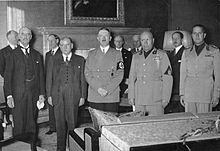
Germany's annexation of the Sudetenland from Czechoslovakia in September 1938 came about during talks with British Prime Minister Neville Chamberlain, in which Hitler, backed by Italian dictator Benito Mussolini, demanded that the German territories be ceded. Chamberlain and Hitler came to an agreement when Hitler signed a piece of paper which said that with the annexation of the Sudetenland, Germany would proceed with no further territorial aims. Chamberlain took this to be a success in that it avoided a potential war with Germany. However, the Nazis helped to promote Slovakian dissention and declaring that the country was no more, seized control of the Czech part.
Molotov-Ribbentrop Pact
For quite some time, Germany had engaged in informal negotiations with Poland regarding the issue of territorial revision, but after the Munich Agreement and the reacquisition of Memel, the Nazis became increasingly vocal. Poland refused to allow the annexation of the Free City of Danzig.
Germany and the Soviet Union began talks over planning an invasion of Poland. In August 1939, the Molotov Pact was signed and Germany and the Soviet Union agreed to divide Poland along a mutually agreed set boundary. The invasion was put into effect on 1 September 1939. Last-minute Polish-German diplomatic proceedings failed, and Germany invaded Poland as scheduled. Germany alleged that Polish operatives had attacked German positions, but the result was the outbreak of World War II in Europe, as Allied forces refused to accept Germany's claims on Poland and blamed Germany for the conflict.
Wartime
From 1939–1940, the so-called " Phoney War" occurred, as German forces made no further advances but instead, both the Axis and Allies engaged in a propaganda campaign. However in early 1940, Germany began to be concerned that the British intended to stop trade between Sweden and Germany by bringing Norway into an alliance against Germany. With Norway in Allied hands, the Allies would be dangerously close to German territory. In response, Germany invaded Denmark and Norway, ending the Phoney War (leapfrogging the British invasion troops bound towards Norway by just 24 hours). After sweeping through the Low Countries and occupying northern France, Germany allowed French nationalist and war hero Philippe Petain to form a fascist regime in southern France known as the "French State" but more commonly referred to as Vichy France named after its capital in Vichy.
On 23 October 1940 Hitler and Francisco Franco, the dictator of Spain, met in Hendaye to discuss Spain entering the war. Franco asked too much from Hitler. Even though Spain would remain neutral during World War II, Spain and Nazi Germany would remain allies during the war. Spain would send volunteer soldiers to fight for Germany but only against the Soviet Union. Spain was subsequently isolated following the war until re-aligning towards economic liberalism and a pro-Western foreign policy in the 1950s.
In 1941, Germany's invasion of Yugoslavia resulted in that state's splintering. In spite of Hitler's earlier view of inferiority of all Slavs, he supported Mussolini's agenda of creating a fascist puppet state of Croatia, called the Independent State of Croatia. Croatia was led by the extreme nationalist Ante Pavelić a long-time Croatian exile in Rome, whose Ustashe movement formed a government in modern-day Croatia and Bosnia and Herzegovina. The Ustashe were allowed to persecute Serbs, while Germany contributed to that goal in the Territory of the Military Commander in Serbia.
From 1941 to the end of the war, Germany engaged in war with the Soviet Union in its attempt to create the Nazi colonial goal of Lebensraum for German citizens. The German occupation authorities set up occupation and colonial authorities called Reichskommissariats such as Reichskommissariat Ostland and Reichskommissariat Ukraine. The Slavic populations were to be destroyed—along with Jews there—to make way for German colonists.
As the fortunes of war changed, Germany was forced to occupy Italy when Mussolini was thrown out as Prime Minister by Italy's king in 1943. German forces rescued Mussolini and instructed him to establish a fascist regime in Italy called the Italian Social Republic. This was the last major foreign policy delivered. The remainder of the war saw the decline of German power and desperate attempts by Nazi officials such as Heinrich Himmler to negotiate a peace with the western Allies against the wishes of Hitler.
Military and paramilitary

Wehrmacht
The military of the Third Reich – the Wehrmacht – was the name of the unified armed forces of Germany from 1935–1945 with Heer (army), Kriegsmarine (navy), Luftwaffe (air force) and a military organization Waffen-SS (military branch of the SS, which was, de facto, a fourth branch of the Wehrmacht).
The German Army furthered concepts pioneered during World War I, combining Ground and Air Force assets into combined arms teams. Coupled with traditional war fighting methods such as encirclements and the "battle of annihilation", the German military managed many lightning quick victories in the first year of World War II, prompting foreign journalists to create a new word for what they witnessed: Blitzkrieg. The total number of soldiers who served in the Wehrmacht during its existence from 1935–1945 is believed to approach 18.2 million. Officially, roughly 5.3 million German soldiers died in the course of the war.
The SA and SS
To secure their ability to create a totalitarian state, the Nazi party's paramilitary force, the Sturmabteilung (SA) or "Storm Detachment" used acts of violence against leftists, communists, democrats, Jews and other opposition or minority groups. The SA "storm troopers" violently clashed with the Communist Party of Germany (German Kommunistische Partei Deutschlands – KPD) which created a climate of lawlessness and fear. In the cities, people were anxious over punishment or even death, if they displayed opposition to the Nazis. Given the frustrations of the people (after World War I and during the Great Depression) it was easy for the SA to attract large numbers of alienated (and unemployed) youth and working-class people for the party.
Economy
Reich economics
When the Nazis assumed German government, their most pressing economic matter was a national unemployment rate of approximately 30 per cent; at the start, Third Reich economic policies were the brainchildren of the economist Dr. Hjalmar Schacht, President of the Reichsbank (1933) and Minister of Economics (1934), who helped Reichskanzler Adolf Hitler implement Nazi redevelopment, reindustrialization, and rearmament of Germany; formerly, he had been Weimar Republic currency commissioner and Reichsbank president. As Economics Minister, Schacht was one of few ministers who took advantage of the administrative freedom allowed by the removal of the Reichsmark from the gold standard—to maintain low interest rates, and high government deficits; the extensive national public works such as the Autobahns, reducing the unemployment, were deficit-funded policy. The consequence of Economics Minister Schacht's administration was the extremely rapid unemployment-rate decline, the greatest of any country during the Great Depression. Eventually, this Keynesian economic policy was supplemented by the increased production demands of warfare, inflating military budgets, and increasing government spending; the Reichswehr (100,000 in the army) expanded to millions, and was renamed Wehrmacht in 1935.
While the strict state intervention into the economy, and the massive rearmament policy, almost led to full employment during the 1930s (statistics didn't include non-citizens or women), real wages in Germany dropped by roughly 25% between 1933 and 1938. Trade unions were abolished, as well as collective bargaining and the right to strike. The right to quit also disappeared: Labour books were introduced in 1935, and required the consent of the previous employer in order to be hired for another job.
Nazi control of business retained a diminished investment profit-incentive, controlled with economic regulation concording a company's functioning with the Reich's national production requirements. Government financing eventually dominated private investment; in the 1933–34 biennium, the proportion of private securities issued diminished from more than 50 per cent of the total, to approximately 10 per cent in the 1935–38 quadrennium. Heavy profit taxes limited self-financing companies, and the largest companies (usually government contractors) mostly were exempted from paying taxes on profits—in practice. Peter Temin writes that government control allowed “only the shell of private ownership” in the Third Reich economy. By contrast, Christoph Buchheim and Jonas Scherner counter that despite state control, business had much production and investment planning freedom — while the economy was still to a larger degree politically controlled it "does not necessarily mean that private property of enterprises was not of any significance [...] For despite extensive regulatory activity by an interventionist public administration, firms preserved a good deal of their autonomy even under the Nazi regime".
In 1937, Hermann Göring replaced Hjalmar Schacht as Minister of Economics, and introduced the Four Year Plan that would establish German self-sufficiency for war—within four years—by curtailing foreign importations; fixing wages and prices (violators merited concentration-camp internment); stock dividends were restricted to six per cent on book capital, et cetera. Strategic goals were to be achieved regardless of cost (as in Soviet economics): thus the rapid construction of synthetic-rubber factories, steel mills, automatic textile mills, et cetera. The Four Year Plan is discussed in the German-expansion Hossbach Memorandum (5 November 1937) meeting-summary of Hitler and his military and foreign policy leaders planning aggressive war. Nevertheless, when Nazi Germany started World War II, in September 1939, the Four Year Plan's expiry was not until 1940; to control the Reich economy, Economics Minister Göring had established the Office of the Four Year Plan.
Science and technology
Transportation and infrastructure
Wartime economy and forced labor
In keeping with the political syncretism of fascism, the Nazi war economy was a mixed economy of free-market and central-planning practices; historian Richard Overy reports: "The German economy fell between two stools. It was not enough of a command economy to do what the Soviet system could do; yet it was not capitalist enough to rely, as America did, on the recruitment of private enterprise."
In 1942, after the death of Fritz Todt, Hitler named his favourite architect, Albert Speer, in charge of the domestic economy. Speer established a war economy in Nazi Germany, which reduced civilian consumptions and made the war economy more efficient.
By 1944, the war was consuming 75% of German GDP, compared to 60% in the Soviet Union, 55% in Britain, and 45% in the U.S.
The highest high priority went to the manufacture of warplanes, which had been poorly coordinated and relied too heavily on skilled workers, who were in short supply. Speer produced a dramatic rise in production after 1942. His methods included streamlined organization, the use of single-purpose machines operated by unskilled workers, and the rationalization of production methods, and better coordination between the many different forms that made tens of thousands of components. Factories were relocated away from rail yards which were bombing targets. The system finally caught up with British production by 1944, but by then it was far too late and gasoline supplies meant the new warplanes had little flying time.
The economy now relied heavily upon the large-scale employment of forced labourers. To help operate the factories and farms, Germany took in some 12 million people, from some 20 European countries; approximately 75 per cent were Eastern European. They worked long hours, typically in munitions factories; many were assigned to clearing rubble after bombing raids. They received poor air raid protection, and many were casualties of Allied bombing. The very bad living conditions produced high rates of sickness, injury and death, as well as sabotage and criminality.
Women played an increasingly large role. Hagemann reports that in 1944 over a half million served as auxiliaries in the German armed forces, especially in anti-aircraft units of the Luftwaffe; a half million worked in civil aerial defense; and 400,000 were volunteer nurses in hospitals. Large numbers replaced drafted men in the wartime economy, especially on farms and in small family-owned shops.
Very heavy strategic bombing by the U.S. and Britain focused on the German transportation system, especially rail yards, canals, and refineries making synthetic oil and gasoline. The Luftwaffe tried to defend those targets but in turn was itself destroyed. Oil, diesel and gasoline supplies dried up by late 1944, and the railways were so disrupted that the economy went into a death spiral. Overy argues that the bombing created not only major social dislocation but a defensive response that strained the German war economy and forced it to divert up to one-fourth of its manpower and industry into anti-aircraft resources. Overy concludes the bombing campaign probably shortened the war.
Demographics
Ethnic groups
Language
Religions
The German census of May 1939 indicates that 54 percent of Germans considered themselves Protestant and 40 percent considered themselves Catholic, with only 3.5 percent claiming to be neo-pagan "believers in God," and 1.5 percent unbelievers. This census came more than six years into the Nazi era.
Education
Education under the Nazi regime focused on racial biology, population policy, culture, geography and especially physical fitness. Military education (Wehrerziehung) became the central component of physical education in order to prepare the Germans mentally, spiritually and physically for warfare. Science textbooks presented natural selection in terms meant to underline the concept of racial purity.
Anti-Semitic policy led to the expulsion in 1933 all of Jewish teachers, professors and officials from the education system. Likewise, politically undesirable teachers, such as socialists, were expelled as part of the “Law for the Restoration of the Civil Service” (Gesetz zur Wiederherstellung des Berufbeamtentums). Most teachers were required to belong to the National Socialist Teachers' Association (Nationalsozialistischer Lehrerbund, NSLB). All university professors were required to be a member in good standing of the National Socialist Association of University Lecturers.
The teaching methods promoted under National Socialism were experiential and active in their orientation. This was largely an extension of the anti-intellectual attitude of the Nazi leadership, however, and not primarily an attempt to experiment with new didactic methods. As Henrich Hansen, the head of the NS-Teachers' Association, put it:
- "The youth of Germany will no longer be 'objectively' posed with the choice between an upbringing that is materialistic or idealistic, ethnic [Völkish] or international, religious or godless, rather it will be consciously formed according to principles that have shown themselves to be true: the principles of the national socialist worldview.
In seeking a way to make education less abstract, less intellectual and less distant from children, educators called for a much-expanded role for film. Reichsfilmintendant and Head of the Film Section in the Propaganda Ministry Fritz Hippler wrote that film affects people “primarily on the optical and emotional, that is to say, non-intellectual” level. Film also appealed to the Nazi leadership as a medium through which they could speak directly to children. Dr. Bernhard Rust saw film as an essential tool, saying "The National Socialist State definitely and deliberately makes film the transmitter of its ideology."
Health
According to the research of Robert N. Proctor for his book The Nazi War on Cancer, Nazi Germany had arguably the most powerful anti-tobacco movement in the world. Anti-tobacco research received a strong backing from the government, and German scientists proved that cigarette smoke could cause cancer. Pioneering German research on experimental epidemiology led to the 1939 paper by Franz H. Müller, and the 1943 paper by Eberhard Schairer and Erich Schöniger which convincingly demonstrated that tobacco smoking was a main culprit in lung cancer. The government urged German doctors to counsel patients against tobacco use. German research on the dangers of tobacco was silenced after the war, and the dangers of tobacco had to be rediscovered by American and English scientists in the early 1950s, with a medical consensus arising in the early 1960s.
German scientists also proved that asbestos was a health hazard, and in 1943—as the first nation in the world to offer such a benefit—Germany recognized the diseases caused by asbestos, e.g., lung cancer, as occupational illnesses eligible for compensation. The German asbestos-cancer research was later used by American lawyers doing battle against the Johns-Manville Corporation.
As part of the general public-health campaign in Nazi Germany, water supplies were cleaned up, lead and mercury were removed from consumer products, and women were urged to undergo regular screenings for breast cancer.
The Nazi health care system also held as a central idea the concept of eugenics. Certain people were deemed 'genetically inferior' and were targeted for elimination from the gene pool through sterilization ( Hereditary Health Courts) or wholesale murder ( Action T4). Medical information professionals used new processes and technology, like punch card systems, and cost analysis, to aid in the process and calculate the 'benefit' to society of these killings.
Society
Social welfare
Recent research by academics such as Götz Aly has emphasized the role of the extensive Nazi social welfare programs that focused on providing employment for German citizens and ensuring a minimal living standard for German citizens. Heavily focused on was the idea of a national German community or Volksgemeinschaft.
To aid the fostering of a feeling of community, the German people's labour and entertainment experiences—from festivals, to vacation trips and traveling cinemas—were all made a part of the " Strength Through Joy" (Kraft durch Freude, KdF) program. Also crucial to the building of loyalty and comradeship was the implementation of the National Labour Service and the Hitler Youth Organization, with compulsory membership. In addition to this, a number of architectural projects were undertaken. KdF created the KdF-wagen, later known as the Volkswagen ("People's Car"), which was designed to be an automobile that every German citizen would be able to afford. With the outbreak of World War II the car was converted into a military vehicle and civilian production was stopped. Another national project undertaken was the construction of the Autobahn, which made it the first freeway system in the world.
The Winter Relief campaigns not only collected charity for the unfortunate, but acted as a ritual to generate public feeling. As part of the centralization of Nazi Germany, posters urged people to donate rather than to give directly to beggars.
Racial policy
From the very earliest speeches and writings of Hitler, it was clear that the Jewish community in Germany was an object of hatred. Nazi ideology laid down strict rules about who was or was not of pure " Aryan" blood, and actions were set into motion to purify the Aryan race—which was said to be identical with the Nordic race (followed by lesser sub-races of the Aryan race) to represent an ideal and pure— master race. On 1 April 1933, Hitler declared a national boycott of Jewish places of business. Many Jewish families prepared to leave, but many others hoped that as they were German citizens, their livelihoods and property would be safe.
In 1935 the Nuremberg Laws were enacted, depriving Jews of their German citizenship. Marriage between Jews and Aryans was forbidden. Further rights were lost over the next few years. Jews were excluded from many professions and from shopping at many stores. Many towns posted signs forbidding the entry of Jews.
Overt discrimination
In the years following the Nazi rise to power, many Jews were encouraged to leave the country and did so. By the time the Nuremberg Laws were passed in 1935, Jews were stripped of their German citizenship and denied government employment. Most Jews employed by Germans lost their jobs at this time, which were being taken by unemployed Germans. Notably, the government attempted to send 17,000 German Jews of Polish descent back to Poland.
In November 1938, a young Jewish male in Paris requested an interview with the German ambassador and was shown in to a meeting with a legation secretary, whom he shot and killed in protest against the treatment meted out to his family in Germany. This provided the pretext for a pogrom the Nazi Party incited against the Jews on 9 November 1938, which specifically targeted Jewish businesses. The SA was given the task of attacking synagogues and Jewish property throughout Germany. During Kristallnacht, the Night of Broken Glass, at least ninety-one German Jews were killed and Jewish property throughout Germany was destroyed. This phase of exclusion made it very clear that the Jews in Germany were to be targeted in the future. To further illustrate, the Jewish communities were fined one billion marks and told that they would not receive compensation for their losses. By September 1939, more than 200,000 Jews had left Germany, with the government seizing any property they left behind.
The effects of Nazi social policy in Germany was divided between those considered to be "Aryan" and those considered "non-Aryan", Jewish, or part of other minority groups. For "Aryan" Germans, a number of social policies put through by the regime to benefit them were advanced for the time, including state opposition to the use of tobacco, an end to official stigmatization toward Aryan children who were born from parents outside of marriage, as well as giving financial assistance to Aryan German families who bore children.
Enemies of the Reich killed or sent to concentration camps
The Nazi Party pursued its racial and social policies through persecution and killing of those considered social undesirables or "enemies of the Reich". Especially targeted were minority groups such as Jews, Romani (also known as Gypsies), Jehovah's Witnesses, people with mental or physical disabilities and homosexuals.
In the 1930s, plans to isolate and eventually eliminate Jews completely in Germany began with the construction of ghettos, concentration camps, and labour camps which began with the 1933 construction of the Dachau concentration camp, which Heinrich Himmler officially described as "the first concentration camp for political prisoners."
The Nazis also undertook programs targeting "weak" or "unfit" people, such as the T-4 Euthanasia Program, killing tens of thousands of disabled and sick Germans in an effort to "maintain the purity of the Aryan Master race" (German: Herrenvolk) as described by Nazi propagandists. The techniques of mass killing developed in these efforts would later be used in the Holocaust. Under a law passed in 1933, the Nazi regime carried out the compulsory sterilization of over 400,000 individuals labeled as having hereditary defects, ranging from mental illness to alcoholism.
Lebensborn
Another component of the Nazi programme of creating racial purity was the Lebensborn, or "Fountain of Life" program founded in 1935. The program was aimed at encouraging German soldiers—mainly SS—to reproduce. This included offering SS families support services (including the adoption of racially pure children into suitable SS families) and accommodating racially valuable women, pregnant with mainly SS men's children, in care homes in Germany and throughout Occupied Europe. Lebensborn also expanded to encompass the placing of racially pure children forcibly seized from occupied countries—such as Poland—with German families.
Prejudice against Slavic peoples
The Nazis conception of the Aryan race viewed Slavs as a racially inferior group from being part of the master race, regarding Slavs as having dangerous Jewish and Asiatic influences, which made them belong to Jewish Bolshevism. The Nazis for this reason described them as untermenschen ("subhuman"). The Nazis used this as propaganda for their political motives as justification for their expansionist policy and especially their aggression against Poland and the Soviet Union in order to conquer Lebensraum ("living space"), particularly in Ukraine. Early plans for the expansion of the German Reich (summarized as Generalplan Ost) envisaged the displacement, enslavement, and elimination of no less than 50 million people who were not considered fit for Germanization from territories it wanted to conquer in Europe, Ukraine's "chornozem" (black earth) soil being a particularly desirable zone for colonization by the "Herrenvolk" (" master race"). Nevertheless, the Nazis recognized that some Slavs (especially the ones with supposed Nordic features) were suitably "valuable" and would be Germanised.
In 1941 it was decided to destroy the Polish nation completely and the German leadership decided that in 10 to 20 years the Polish state under German occupation was to be fully cleared of any Poles and settled by German colonists. The Nazis considered Jews, Romani people, Poles along with other Slavic people like the Russians, Ukrainians, Czechs and anyone else who was not an " Aryan" according to the contemporary Nazi race terminology to be Untermenschen ("subhumans"), although many Slavs (especially the ones with Nordic features) were considered and accepted as Aryans. The Nazis rationalized that the Aryans had a biological right to displace, eliminate, and enslave inferiors. After the war, under the "Big Plan", Generalplan Ost foresaw the deportation of 45 million non- Germanizable people from Eastern Europe to West Siberia, and about 14 millions were to remain, but were to be treated as slaves. In their place, Germans would be settled in an extended lebensraum of the 1000-Year Empire.
Herbert Backe was one of the orchestrators of the Hunger Plan—the plan to starve tens of millions of Slavs in order to ensure steady food supplies for the German people and troops. In the longer term, the Nazis wanted to exterminate some 30–45 million Slavs. According to Michael Dorland, "As Yale historian Timothy Snyder reminds us, had the Nazis succeeded in their war on Russia, the implementation of two further dimensions of the Holocaust, the Hunger Plan and Generalplan Ost, would have led to the elimination through starvation of an additional 80 million people in Belarus, northern Russia and the USSR."
At the outset of World War II, the German authority in the General Government in occupied Poland ordered that all Jews face compulsory labour and that those who were physically incapable such as women and children were to be confined to ghettos.
The "Final Solution"
To the Nazis, a number of ideas appeared on how to answer the "Jewish Question". One method was a mass forced deportation of Jews. Adolf Eichmann suggested that Jews be forced to emigrate to Palestine. Franz Rademacher made the proposal that Jews be deported to Madagascar; this proposal was supported by Himmler and was discussed by Hitler and Italian dictator Benito Mussolini but was later dismissed as impractical in 1942. The idea of continuing deportations to occupied Poland was rejected by the governor, Hans Frank, of the General Government of occupied Poland as Frank refused to accept any more deportations of Jews to the territory which already had large numbers of Jews. In 1942, at the Wannsee Conference, Nazi officials decided to eliminate the Jews altogether, as discussed in the " Final Solution of the Jewish Question". Concentration camps like Auschwitz were converted to extermination camps and used gas chambers to kill as many Jews as possible. By 1945, a number of concentration camps had been liberated by Allied forces and they found the survivors to be severely malnourished. The Allies also found evidence that the Nazis were profiteering from the mass murder of Jews not only by confiscating their property and personal valuables but also by extracting gold fillings from the bodies of some Jews held in concentration camps.
Role of women and family
Women in the Third Reich were a cornerstone of Nazi social policy. The Nazis opposed the feminist movement, claiming that it had a left-wing agenda (comparable to Communism) and was bad for both women and men. The Nazi regime advocated a patriarchal society in which German women would recognize the "world is her husband, her family, her children, and her home." Hitler claimed that women taking vital jobs away from men during the Great Depression was economically bad for families in that women were paid only 66 percent of what men earned. Simultaneously with calling for women to leave work outside the home, the regime called for women to be actively supportive of the state regarding women's affairs. In 1933, Hitler appointed Gertrud Scholtz-Klink as the leader of the National Socialist Women's League, which instructed women that their primary role in society was to bear children and that women should be subservient to men, once saying "the mission of woman is to minister in the home and in her profession to the needs of life from the first to last moment of man's existence.". The expectation even applied to Aryan women married to Jewish men—a necessary ingredient in the 1943 Rosenstrasse protest in which 1800 German women (joined by 4200 relatives) obliged the Nazi state to release their Jewish husbands. This position was so strongly held as to make it extremely difficult to recruit women for war jobs during World War II.
The Nazi regime discouraged women from seeking higher education in secondary schools, universities and colleges. The number of women allowed to enroll in universities dropped drastically under the Nazi regime, which shrank from approximately 128,000 women being enrolled in 1933 to 51,000 in 1938. Female enrollment in secondary schools dropped from 437,000 in 1926 to 205,000 in 1937. However with the requirement of men to be enlisted into the German armed forces during the war, women made up half of the enrollment in the education system by 1944.
On the other hand, the women were expected to be strong, healthy, and vital; a photograph subtitled "Future Mothers" showed teenage girls dressed for sport and bearing javelins. A sturdy peasant woman, who worked the land and bore strong children, was an ideal, contributing to praise for athletic women tanned by outdoor work.
Organizations were made for the indoctrination of Nazi values to German women. Such organizations included the Jungmädel ("Young Girls") section of the Hitler Youth for girls from the age 10 to 14, the Bund Deutscher Mädel (BDM, "German Girls' League") for young women from 14 to 18, and the NS-Frauenschaft, a woman's organization.
The NS-Frauenschaft put out the NS-Frauen-Warte, the only approved women's magazine in Nazi Germany. Despite its propaganda aspects, it was predominantly a woman's magazine, even including sewing patterns.
The BDM's activities encompassed physical education, including running, the long jump, somersaulting, tightrope walking, rout-marching, and swimming. Das deutsche Mädel was less adventure-oriented than the boy's Der Pimpf, but far more emphasis was laid on strong and active German women than in NS-Frauen-Warte. Also, before entering any occupation or advanced studies, the girls, like the boys in Hitler Youth, had to complete a year of land service.
Despite the somewhat official restrictions, some women forged highly visible, as well as officially praised, achievements, such as the aviatrix Hanna Reitsch and film director Leni Riefenstahl.
On the issue of sexual affairs regarding women, Biddiscombe argues the Nazis differed greatly from the restrictive stances on women's role in society. The Nazi regime promoted a liberal code of conduct as regards sexual matters, and were sympathetic to women bearing children out of wedlock. The collapse of 19th century morals in Germany accelerated during the Third Reich, partly due to the Nazis, and greatly due to the effects of the war. Promiscuity increased greatly as the war progressed, with unmarried soldiers often involved intimately with several women simultaneously. Married women were often involved in multiple affairs simultaneously, with soldiers, civilians or slave labourers. "Some farm wives in Württemberg had already begun using sex as a commodity, employing carnal favours as a means of getting a full day's work from foreign labourers." Nevertheless, publicly, Nazi propaganda opposed adultery and upheld the sanctity of marriage. Several films shot in this era altered their source material so that the woman, rather than the man, would suffer death for sexual transgressions, reflecting whose fault it was held to be. When attempts were made to destigmatize illegitimate births, Lebensborn homes were presented to the public as being for married women. Overtly anti-marriage statements, such as Himmler's statements regarding the care of the illegitimate children of dead soldiers, were greeted with protests. Ilsa McKee noted that the lectures of Hitler Youth and the BDM on the need to produce more children produced several illegitimate children, which neither the mothers nor the possible fathers regarded as problematic.
Marriage or sexual relations between a person considered “Aryan” and one that was not were classified as Rassenschande and were forbidden and under penalty (Aryans found guilty could face incarceration in a concentration camp, while non-Aryans could face the death penalty). Pamphlets enjoined all German women to avoid sexual intercourse with all foreign workers brought to Germany as a danger to their blood.
Abortion was heavily penalized in Nazi Germany unless on the grounds of "racial health": from 1943 abortionists faced the death penalty. Display of contraceptives was not allowed, and Hitler himself described contraception as "violation of nature, a degradation of womanhood, motherhood and love."
Environmentalism
In 1935, the regime enacted the "Reich Nature Protection Act". While not a purely Nazi piece of legislation, as parts of its influences pre-dated the Nazi rise to power, it nevertheless reflected Nazi ideology. The concept of the Dauerwald (best translated as the "perpetual forest") which included concepts such as forest management and protection was promoted and efforts were also made to curb air pollution.
In practice, the enacted laws and policies met resistance from various ministries that sought to undermine them, and from the priority that the war-effort took to environmental protection.
Animal protection policy
The Nazis had elements which were supportive of animal rights, zoos and wildlife, and took several measures to ensure their protection. In 1933 the government enacted a stringent animal-protection law. Many NSDAP leaders, including Hitler and Göring, were supporters of animal protection. Several Nazis were environmentalists (notably Rudolf Hess), and species protection and animal welfare were significant issues in the regime. Himmler made efforts to ban the hunting of animals. Göring was an animal lover and conservationist. The current animal welfare laws in Germany are adapted from laws introduced by the National Socialist regime.
Although enacting various laws for animal protection, there was a lack of enforcement. According to Pfugers Archiv für die Gesamte Physiologie (Pfugers Archive for the Total Physiology), a science journal at that time, there were many animal experiments during the Nazi regime. The Nazi regime disbanded several unofficial organizations advocating environmentalism and animal protection, such as the Friends of Nature.
Culture
The regime sought to restore traditional values in German culture. The art and culture that came to define the Weimar Republic years was repressed. The visual arts were strictly monitored and traditional, focusing on exemplifying Germanic themes, racial purity, militarism, heroism, power, strength, and obedience. Modern abstract art and avant-garde art was removed from museums and put on special display as " degenerate art", where it was to be ridiculed. In one notable example, on 31 March 1937, huge crowds stood in line to view a special display of "degenerate art" in Munich. Art forms considered to be degenerate included Dada, Cubism, Expressionism, Fauvism, Impressionism, New Objectivity, and Surrealism. Literature written by Jewish, other non-Aryans, homosexual or authors opposed to the Nazis was destroyed by the regime. The most infamous destruction of literature was the book burnings by German students in 1933.
Despite the official attempt to forge a pure Germanic culture, one major area of the arts, architecture, under Hitler's personal guidance, was neoclassical, a style based on architecture of ancient Rome. This style stood out in stark contrast and opposition to newer, more liberal, and more popular architecture styles of the time such as Art Deco. Various Roman buildings were examined by state architect Albert Speer for architectural designs for state buildings. Speer constructed huge and imposing structures such as in the Nazi party rally grounds in Nuremberg and the new Reich Chancellery building in Berlin. One design that was pursued, but never built, was a gigantic version of the Pantheon in Rome, called the Volkshalle to be the semi-religious centre of Nazism in a renamed Berlin called Germania, which was to be the "world capital" (Welthauptstadt). Also to be constructed was a Triumphal arch, several times larger than that found in Paris, which was also based upon a classical styling. Many of the designs for Germania were impractical to construct because of their size and the marshy soil underneath Berlin; later the materials that were to be used for construction were diverted to the war effort.
Sports
Sports played a central role in the Nazi goal of building strong young athletes to create the "perfect" race and help build Germany into a sports power. The political symbolism of masses of virile near-naked bodies occupying public spaces fit easily into the propaganda system, as typified by the 1938 film about the 1936 Berlin Olympics, "Olympia".
Established in 1934, the " Nationalsozialistischer Reichsbund für Leibesübungen" (known by the acronyms NSRL or NSRBL) was the umbrella organization for sports during the Third Reich. Two major displays of Nazi German art and culture were at the 1936 Summer Olympics and at the German pavilion at the 1937 International Exposition in Paris. The 1936 Olympics was meant to display to the world the Aryan superiority of Germany to other nations. German athletes were carefully chosen not only for strength but for Aryan appearance.
Legacy
Starting with the Nuremberg Trials of 1945–46, in which top Nazi leaders were tried for war crimes (and executed or given long prison terms upon being adjudicated guilty), Hitler, Nazism, and (by the 1960s) the Holocaust became symbols of evil in the modern world. For the 21st century, Newman and Erber (2002) reported, "The Nazis have become one of the most widely recognized images of modern evil. Throughout most of the world today, the concept of evil can readily be evoked by displaying almost any cue reminiscent of Nazism, such as the swastika, the name of any of the principal Nazis, or their garb or affectations...." There is a high level of historical interest in the popular media as well as in academic world. Evans says it, "exerts an almost universal appeal because its murderous racism stands as a warning to the whole of humanity."
The end of Nazi Germany also saw the rise in unpopularity of related aggressive manifestations of nationalism in Germany such as Pan-Germanism and the Völkisch movement which had previously been a significant source of political ideas in Germany, and in other parts of Europe, before World War II. Those that remain are largely fringe movements.




